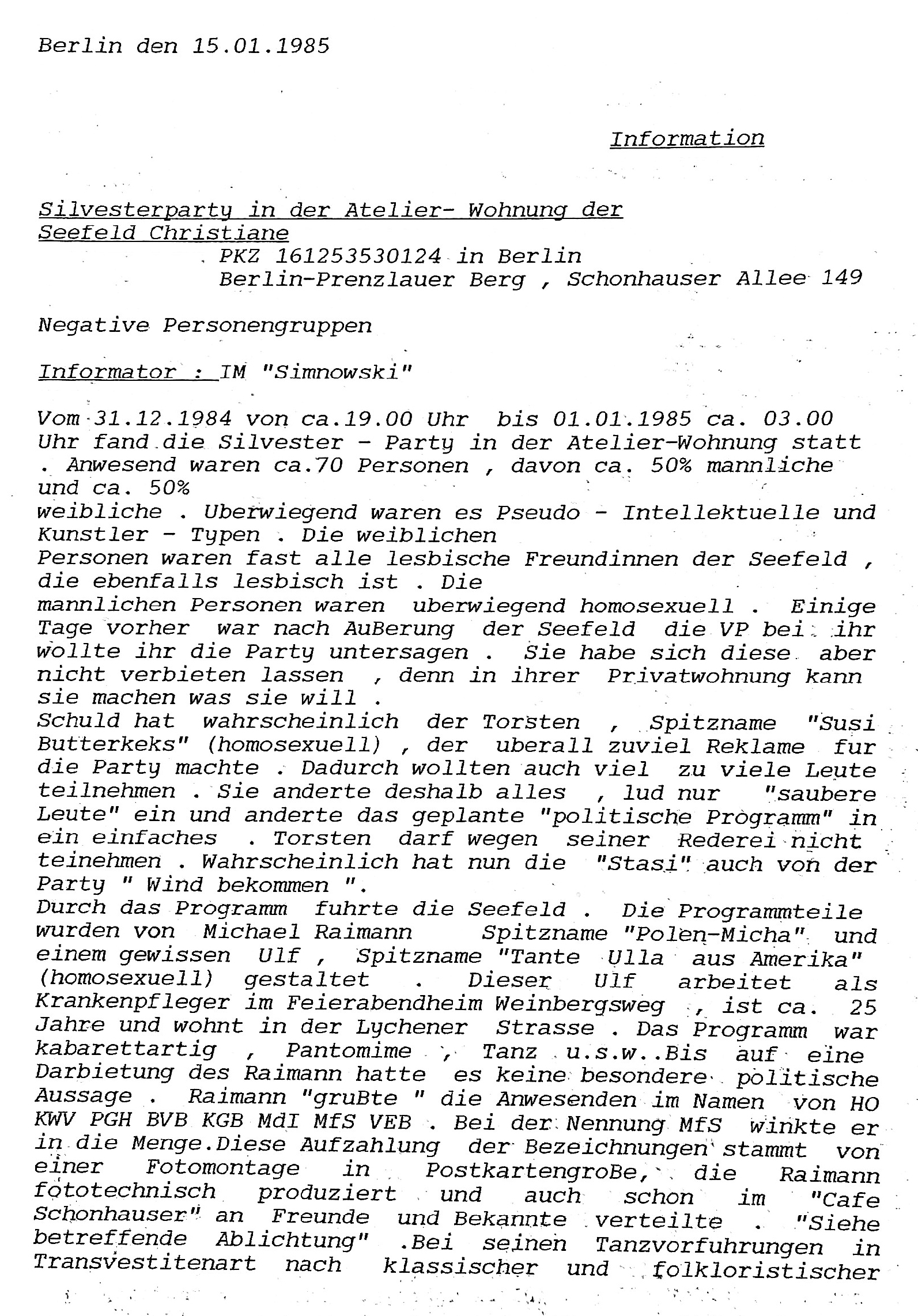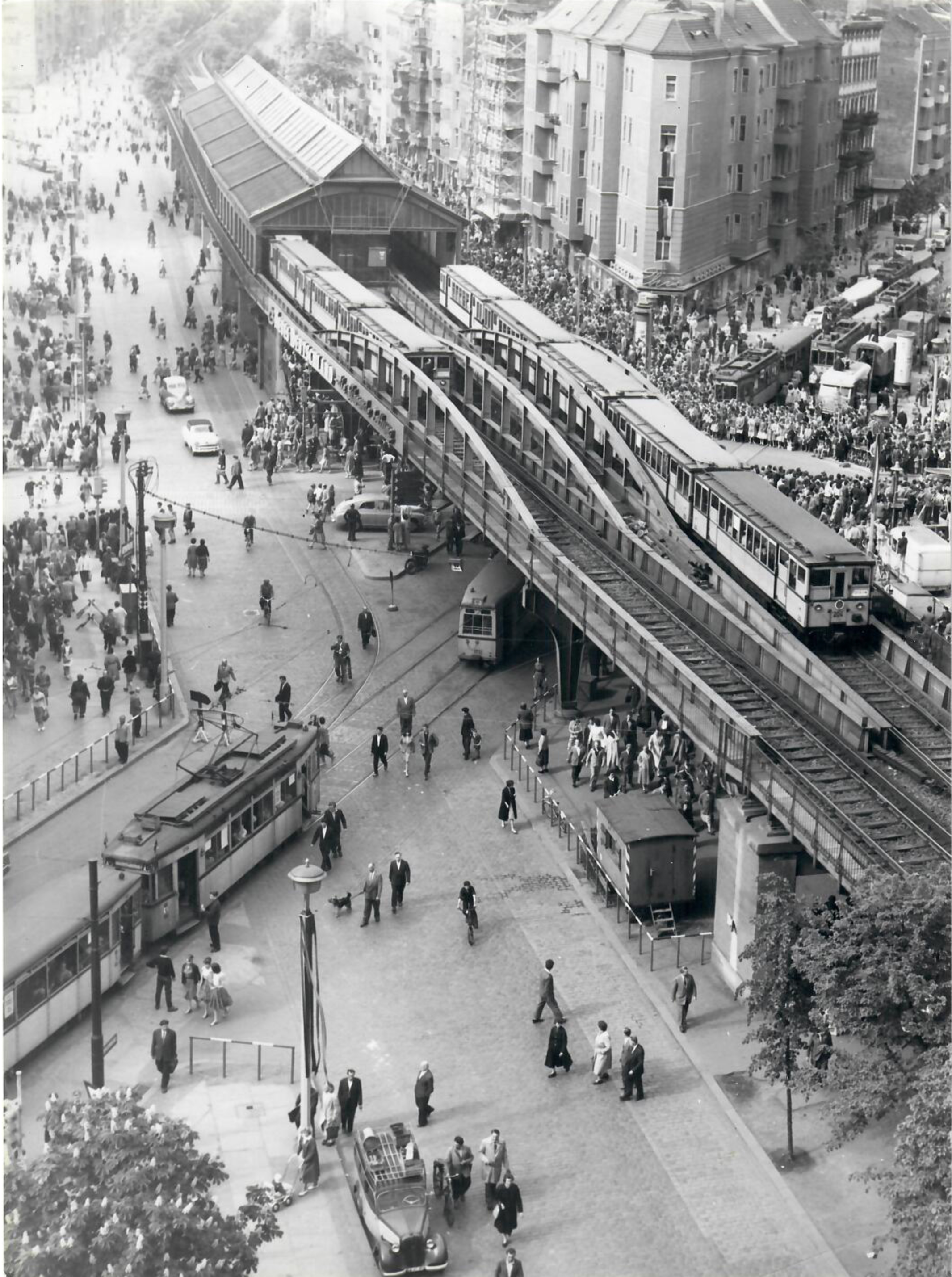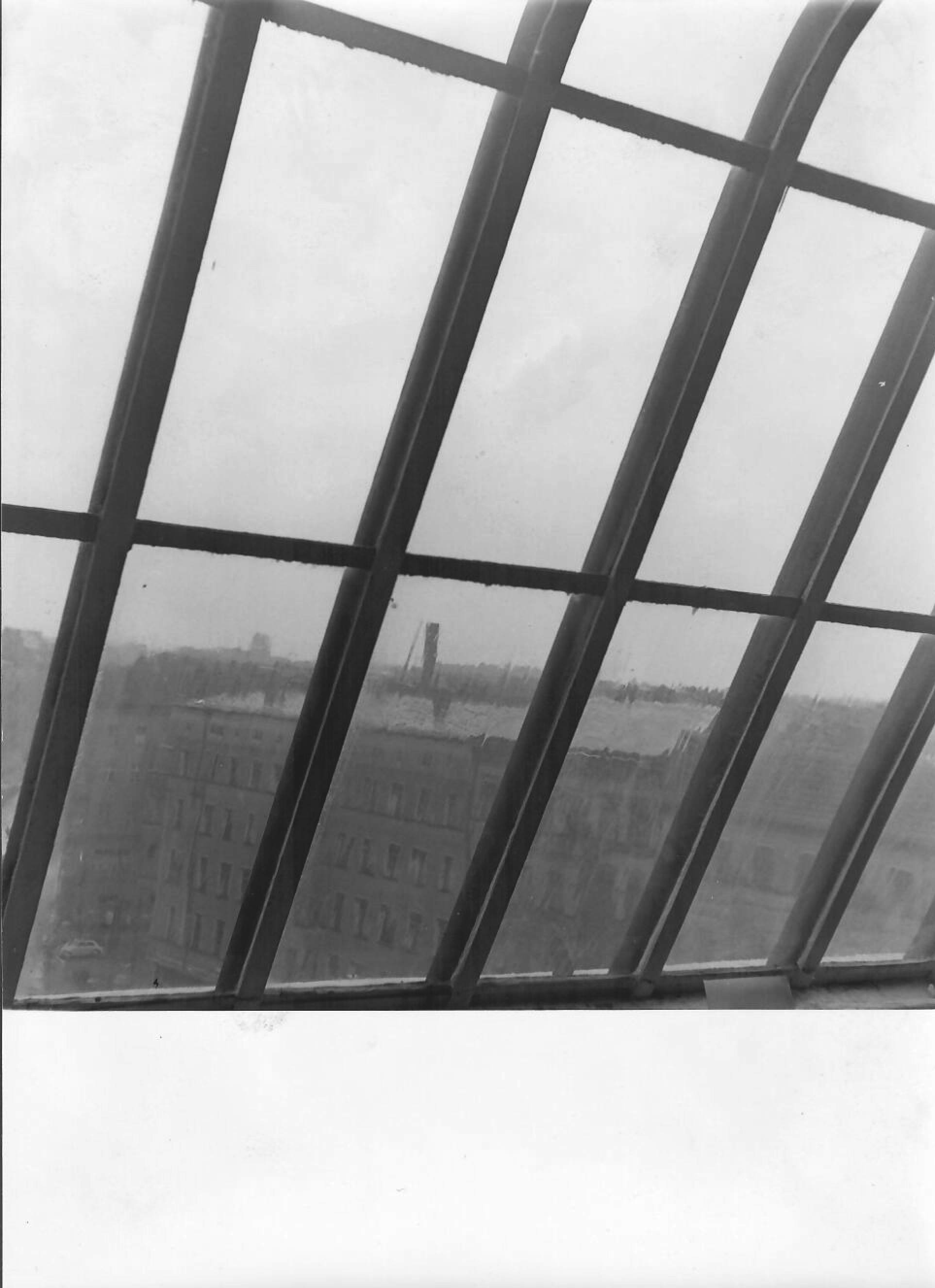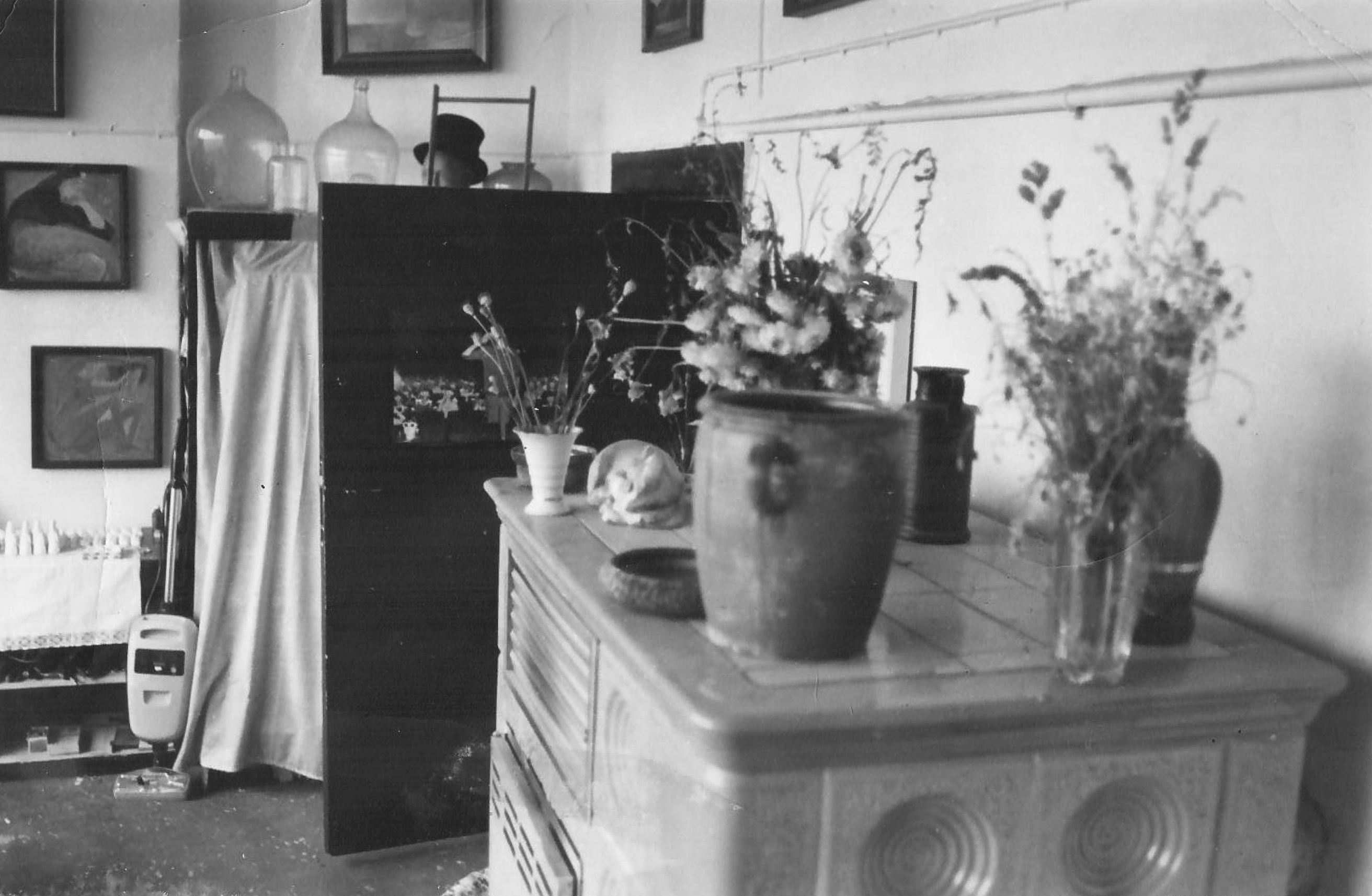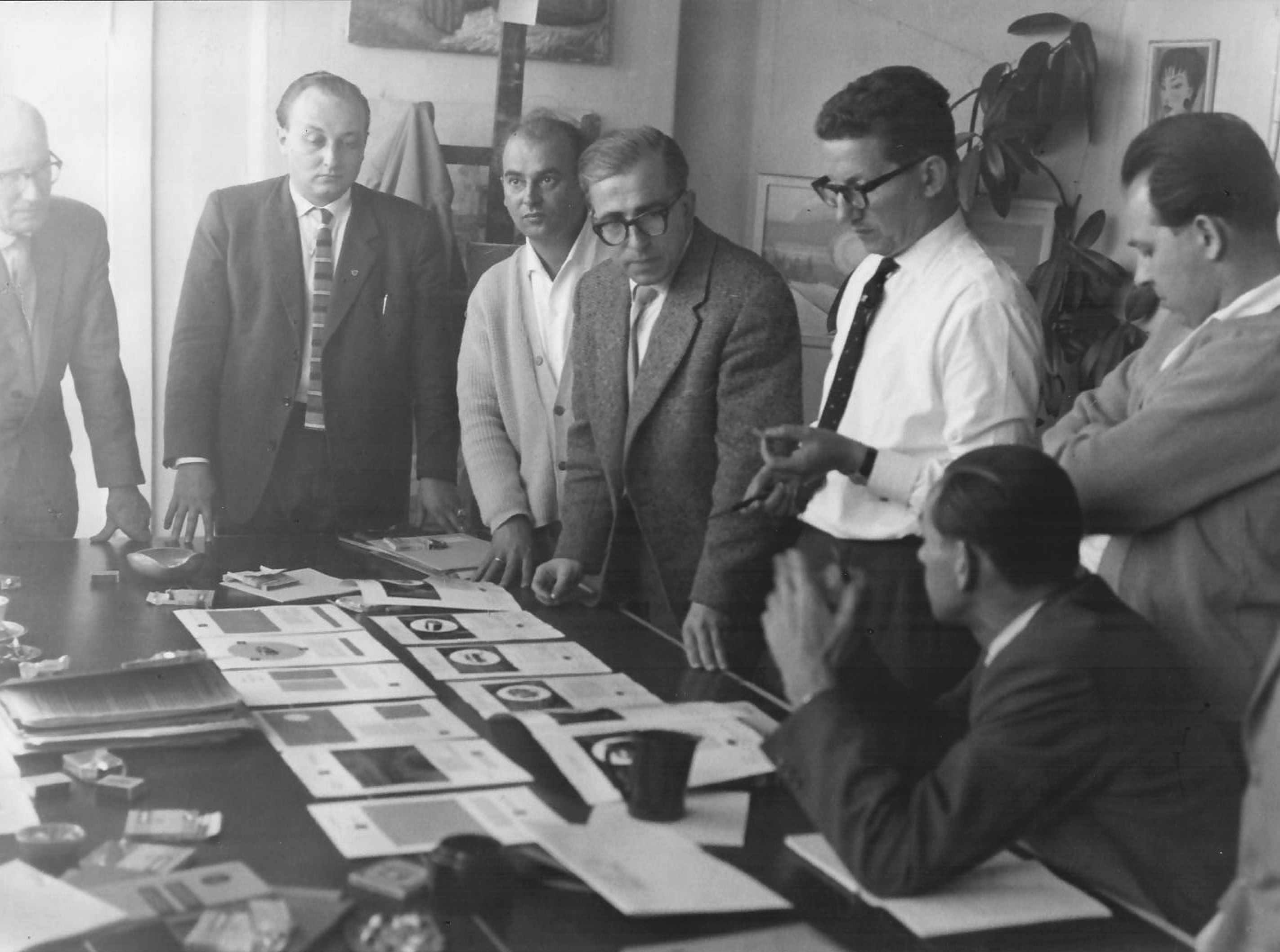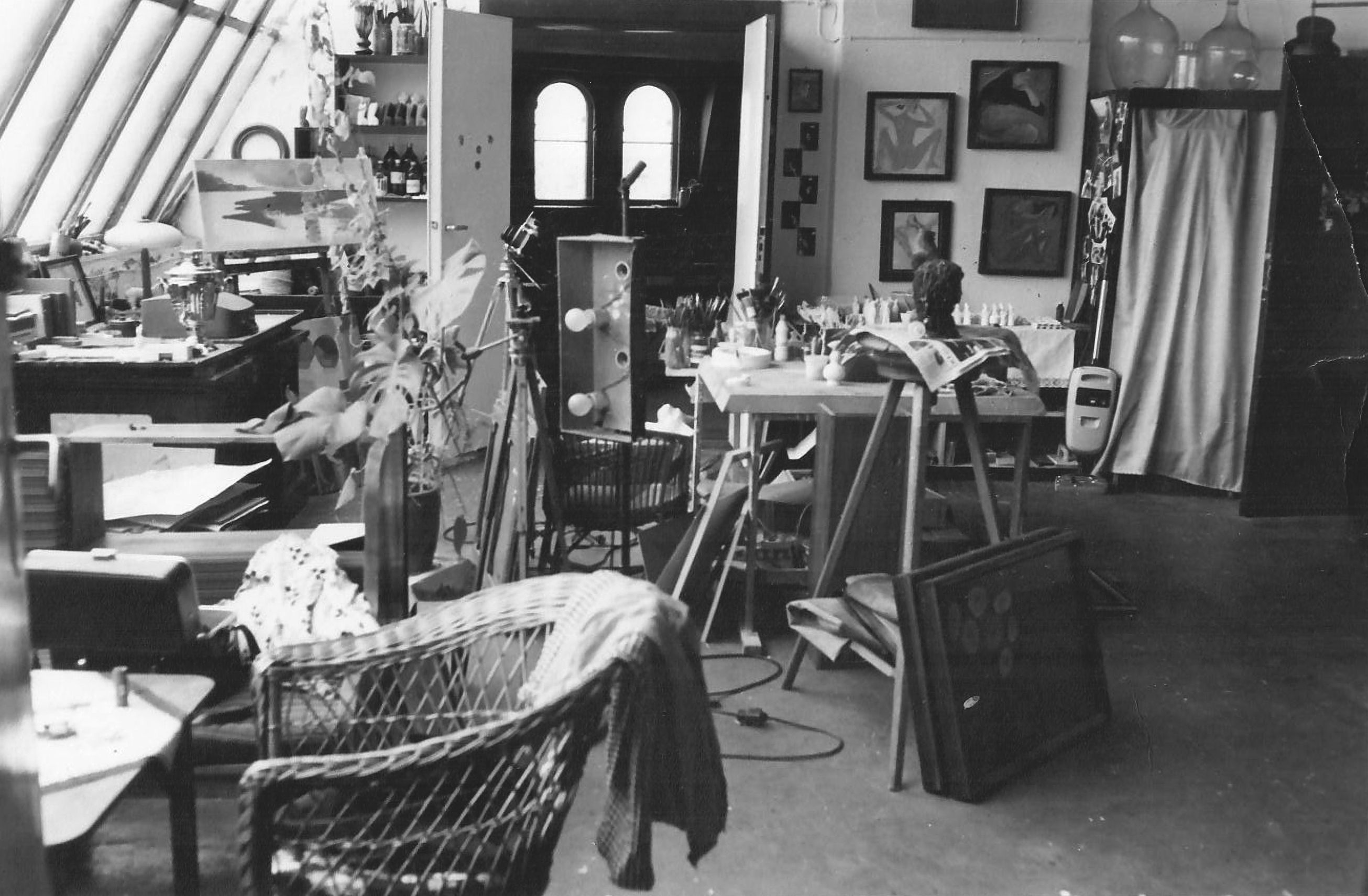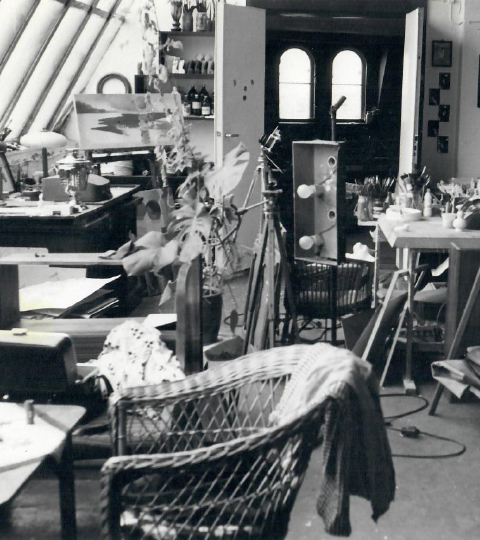Sie nennen mich 🍰 die Kiezmutter
They call me "Kiezmutter"
Akt5: Die Atelierwohnung von Christiane Seefeld als queerer Treffpunkt in Ost-Berlin
Akt5: The atelier apartment of Christiane Seefeld as queer meeting point in East-Berlin
Von der Staatssicherheit bespitzelt hielt Christiane Seefeld politischen Schikanen stand und öffnete ihre Atelierwohnung jahrelang all jenen, die dem heteronormativen Gesellschaftsbild der DDR nicht entsprachen. Von geheimen Arbeitsgruppen, Gesangsproben auf dem Dach bis hin zu Silvesterpartys und drei Stück Kohle Eintritt: was als wöchentliche Kaffeerunde begann, wurde zu einer der wichtigsten Institutionen queerer politischer und künstlerischer Arbeit in Ostberlin und legte den Grundstein für den noch heute aktiven Sonntagsclub. Christiane Seefeld lebt immer noch im Kiez.
Spied on by the state security, Christiane Seefeld withstood political harassment and for years opened her studio apartment to all those who did not conform to the heteronormative social image of the GDR. From secret work groups and singing rehearsals on the roof to New Years parties for three pieces of cole: what began as a weekly coffee round became one of the most important institutions of queer political and artistic work in East Berlin and laid the foundation for what is now Sonntagsclub. Christiane Seefeld still lives in the neighborhood.
Time: 1980's
Lat: 52.540098191844,
Long: 13.411702400318
Published: 06.03.2023
Audio: Deutsch
Image: © Privates Archiv Christiane Seefeld
Directed by/Regie: POLIGONAL
With Voices/Stimmen von: Christiane Seefeld, Catherine Welly und/and Donat Blum
mit Ausschnitte aus einem Stasibericht über/with excerpts from a Stasi report on Christiane Seefeld
Sprecherin/narrator: Mareike Wentzel
Songausschnitt/Song: “der blaue Planet” von/from Karat
Ton und Technik/Sound und Post-produktion: Tobias Purfürst
Audio Transkript DE
Christian Seefeld [00:00:07] Ja, mein Name ist Christiane Seefeld. Mein Künstlername ist Momo.
Cathrine Welly [00:00:18] Ich bin Catherine Welly und bin eine Uralt-Freundin von der Christiane.
Donat Blum [00:00:26] Mein Name ist Donat Blum und ich wohne jetzt in Christiane Seefelds ehemaliger Wohnung.
Christian Seefeld [00:00:45] Ich hab meinen Bruder gefragt, warum er immer traurig ist und er sagte, er kann keinen Mann kennenlernen. Sag ich: wieso? Ich wusste ja nicht was der meint mit "einen Mann". Bis er es mir richtig erklärt. Und dann hab ich gesagt: "Na ja, Habt ihr gar keinen Treffpunkt?" "Doch, es gibt einen in der Schönhauser Allee, den nennt man Klappe." "Ja, was ist denn eine Klappe?" "Na, eine Toilette." Aber da will er nicht hin – das stinkt. Na dann habe ich wieder mal meine Zettelarie gemacht – schön verteilt: immer sonntags gibt es Westkaffee von 16 bis 18 Uhr, weil um 19 Uhr kam meine Tochter, also mussten die da alle wieder raus. Ich wusste ja noch nicht mal, ob ich die richtigen Männer einlade. Und du glaubst es nicht! Am ersten Tag waren 25 Leute da. Das hatten die auch gleich rumgesprochen. Oh, habe ich mich gefreut. Und ich weiß jetzt nicht genau, ob die wegen der Männer gekommen sind oder wegen meinem West-Kaffee. Keine Ahnung, aber ich denke schon, dass die Männer gezogen haben. Das war dann so ein schöner Erfolg und dann habe ich gedacht: machste in kleinen Runden auch für Frauen was. Ich war ja damals, wie man heute sagt, eine Heterosexuelle. Hatte ja keine Ahnung davon. Bis ich mich dann auch verliebt habe in eine Frau und ziemlich lange – sieben Jahre – mit ihr zusammen war. Die ist dann aber in den Westen rüber. Also hier haben ganz schöne Stunden stattgefunden.
Cathrine Welly [00:02:17] Ich habe das noch sehr gut miterlebt, dass es eben keine Treffpunkte gab, außer in der freien Natur. Und deshalb waren Wohnungen, wo Leute uns rein ließen, total begehrt. Und dein Atelier war ja so berühmt, weil das war ja ein riesen Raum, das war ja keine Wohnung in dem Sinne. Da sind jetzt drei kleine Wohnungen daraus entstanden. Das war sieben Meter hoch, ungefähr sechs, sieben Meter hoch.
Christian Seefeld [00:02:37] Also auch mit schrägen Fenstern.
Cathrine Welly [00:02:39] Es ist ja auch ein historischer Bau. Das war ja damals von diesen Gebrüdern Skladanowsky.
Christian Seefeld [00:02:44] Die den ersten Tonfilm gemacht haben.
Cathrine Welly [00:02:46] Das war also immer Atelier. Und da ging natürlich eine Masse Menschen rein. Und dann kam dazu: in der DDR, war ja um 00:00 Uhr alles zu. Außer einem Künstler Club, wo man nur mit Karte reinkam – die Möwe. Ansonsten war um 00:00 Uhr alles geschlossen. Und wenn man in einem Kaffee oder in der Kneipe saß war die Frage: wo gehen wir denn jetzt hin? Ja wer hat denn so viel Platz? Und da warst du natürlich Nummer-Eins im Prenzlauer Berg.
Christian Seefeld [00:03:09] Ja, und es gab ja nicht so einen großen Raum für Menschen, die nicht anerkannt waren in der DDR als Künstler oder so. Sie waren ja trotzdem Künstler und hatten nicht das Geld oder den Raum. Sängerinnen und Sänger haben dann dort oben auf dem Dach Stimmübungen gemacht. Ja, das hätte ich jeden Tag haben können. (lacht)
Cathrine Welly [00:03:27] Und dann hast du ja auch Kabarett gemacht, richtig mit Auftritt. Und natürlich auch politisch. Und das Beste, was Sie gemacht hat war ein Silvester Fest: drei Kohlen und eine Kerze musste man als Eintritt mitbringen, weil: sieben Treppen. Wer schleppt die Kohlen da hoch? Dieser riesen Raum. Wie kriegt man den warm?
Christian Seefeld [00:03:45] Da habe ich noch so eine Postkarte davon.
Cathrine Welly [00:03:46] Da gibt es eine Einladungskarte und da steht wirklich drauf Silvesterparty: eine Kerze und drei Kohlen. So, und dann waren natürlich endlich mal Kohlen da oben. (lacht)
Sprecherin liesst Stasibericht [00:04:00] Auszüge aus einem Stasi Bericht über negative Personengruppen: Berlin, den 15.01.1985 Silvesterparty in der Atelier Wohnung der Seefeld, Christiane. Berlin, Prenzlauer Berg, Schönhauser Allee 149, Informator: Inoffizieller Mitarbeiter "Simnowski"
Cathrine Welly [00:04:22] Und da war natürlich immer jemand von "Kuck und Horch" mit dabei. Das wussten auch alle.
Sprecherin liesst Stasibericht [00:04:26] Vom 31.12.1984 von circa 19:00 bis 01.01.1985, circa 3:00 Uhr, fand die Silvesterparty in der Atelier-Wohnung statt. Anwesend waren circa 70 Personen, davon circa 50 männliche und circa 50 weibliche. Die weiblichen Personen waren fast alle lesbische Freundinnen der Seefeld, die ebenfalls lesbisch ist. Die männlichen Personen waren überwiegend homosexuell. Einige Tage vorher war nach Äußerung der Seefeld die Volkspolizei bei ihr. Wollt ihr die Party untersagen. Sie habe sich diese aber nicht verbieten lassen, denn in ihrer Privatwohnung kann sie machen, was sie will. Durch das Programm führte die Seefeld. Die Programmteile wurden von Michael Reimann, Spitzname "Polen-Micha" und einem gewissen Ulf, Spitzname "Tante Ulla aus Amerika" (homosexuell) gestaltet: kabarettartig, Pantomime, Tanz und so weiter. Bei seinen Tanz Vorführungen in Travestitenart nach klassischer und folkloristischer Schallplatten- und Klaviermusik trug Reimann nur einen ganz knappen Slip und eine Pelz Stola. Neben dem Programm betätigte sich Reimann auch an der Bar. Die Gäste vergnügten sich auf ihre Art, das heißt Rumgeschmuse und Rumgefingere sowie Tanzen der gleichgeschlechtlichen Partner.
Christian Seefeld [00:05:46] Also solche Sachen sind organisiert worden, dass man einfach zusammen sein konnte und sich nicht alleine gefühlt hat. Weil so war das in der DDR, dass sich eben ganz viele Menschen vom "anderen Ufer" allein gefühlt haben. So wie mein Bruder. Das war eher so wie Familie – auch nicht ganz – aber schon eine Gemeinschaft. Und dass wir ungestört sind und dass die Männer oder Frauen oder auch mal küssen konnten. Auf der Straße ging es ja nicht, die Männer und Frauen, die sich geküsst haben auf der Tanzfläche, die wurden auseinandergetrieben. Und die Frauen auch. Weil es nicht gestattet war, das war "unnormal", es passte nicht in die Norm der DDR.
Donat Blum [00:06:34] Christiane Seefeld ist meine Vor-Vor-Vormieterin an der Schönhauser Allee 146, an der sogenannten Ecke Schönhauser Allee, in einem Haus, auf dessen Dach vor mehr als 100 Jahren ein Atelier gebaut wurde – ein Foto-Atelier mit großen Fenstern in den Himmel. Aber wenn man sich ein bisschen nach vorne beugt, dann auch runter auf die Kreuzung Schönhauser Allee, Eberswalder Straße und Kastanienallee, Pappelallee auch noch. Und zwar hat sie in der Wohnung an Sonntagen jeweils Treffen veranstaltet, da haben die sich getroffen und ich weiß gar nicht genau was gemacht und unter anderem auch getanzt. Manchmal kam auch die Polizei. Die Polizei kam in einem Treppenhaus hoch und weil die Wohnung auch noch mit einem anderen Treppenhaus verbunden war, konnten die Leute dann durchs andere Treppenhaus der Polizei entfliehen. Christiane hat eigentlich die meiste Zeit in der Gegend dann auch weiter gewohnt, wohnt jetzt gar nicht weit weg von dieser Wohnung, in der ich jetzt wohne und wird da auch als Kiezmutti bezeichnet, weil sie sich sehr stark für den Kiez engagiert hat. Vor sieben Jahren sind wir zu dritt in einer Dreierbeziehung in diese Wohnung gezogen und haben das da ausprobiert, ob das auch eine Lebensform wäre. Also so ist diese Wohnung mit den doch sehr großen Zimmern ein Begegnungsort geblieben, in dem wir immer wieder andere Konstellationen ausprobieren und versuchen rauszufinden, was denn eigentlich ein liebevolles, glückliches Leben sein könnte oder wie das sein könnte unter Menschen, die sich nicht so direkt in heteronormative Muster einfügen wollen. Inwiefern der Geist von Christiane da also weiterlebt? Er lebt so weiter, dass es ihr damals ein Anliegen war, dass queere Menschen dahin kommen, dass ihr schwuler Bruder Leute kennenlernen konnte. Und das machen wir eigentlich immer noch so!
Christian Seefeld [00:08:45] Der Sonntags Club, der besteht heute noch. Der ist schon zu DDR Zeiten sehr politisch aktiv gewesen und da kamen auch ganz tolle Leute noch dazu, die sich da schriftlich auch sehr gut auskannten und geschrieben haben, sich für unsere Rechte eingesetzt haben. Und der Sonntags Club, der wurde nach der Wende ein Verein. Das ist in der Greifenhagener Straße, Ecke Erich-Weinert Straße. Da ist eine Gaststätte und da befinden sich auch ganz viele Büroräume und da sind ganz viele Veranstaltung und die Leute, die arbeiten da ehrenamtlich. Wir haben jetzt gerade gefeiert: 50 Jahre Sonntagsclub, das war so toll. Ich habe sehr viele Menschen wiedergetroffen, die ich schon jahrelang nicht gesehen habe und es immer, als wenn man nach Hause kommt in der Familie. Ach, ich bin eigentlich zufrieden und glücklich, dass das alles human ausgegangen ist. Dass die da nicht so viele Menschen gekriegt haben und kaputt gemacht haben in der DDR. Die Staatssicherheit, meine ich natürlich, die waren ja immer da. Ach, wie finde ich denn das? Da wohnen möchte ich nicht mehr. Da hat man keine Ruhe. (lacht) Aber ansonsten ... ich habe so viele schöne Stunden erlebt und natürlich auch traurig, wenn wir politisch aktiv waren. Ach, ich sehe immer noch als 40 Menschen anfangen um 24:00 Uhr Walzer zu tanzen. Der ganze Saal! Oh, das war für mich ein Erlebnis. Und die vielen Freundschaften, die ich geschlossen habe. Wir haben uns ja auch immer gegenseitig geholfen. Weiste? Ach ich bin zufrieden und glücklich. Wir haben um in der Jugendsprache zu sprechen, so geile, geile Sachen gemacht! (lacht)
Audio Transcript EN
Christiane Seefeld [00:00:07] Yes, my name is Christiane Seefeld. My stage name is Momo.
Cathrine Welly [00:00:18] I am Catherine Welly and I am an old friend of Christiane's.
Donat Blum [00:00:26] My name is Donat Blum and I am currently living in Christiane Seefeld's former apartment.
Christiane Seefeld [00:00:45] I asked my brother why he is always sad and he said he can't get to know a man. I asked: why? I didn't understand what he meant by “a man.” Until he explained it to me correctly. And then I said, “Well, don't you have a place where you can meet?” “Yes, there is one on Schönhauser Allee called a flap.” “Yes, what is a flap?” “Well, a toilet.” But he didn't want to go there — it stinks. Well then I made one of my flyer campaigns again — distributed nicely: Westkaffee is served every Sunday from 4 pm to 6 pm, because my daughter came at 7 pm, so they all had to get out there again. I didn't even know if I was inviting the right men! And you don't believe it! There were 25 people there on the first day. They had spread the word about that right away. Oh, I was so happy. And I'm not sure now whether they came for the men or for my West-style coffee. I don't know, but I do think the men pulled. That was such a great success and then I thought: Do something for women in small rounds too! Back then, as they say today, I was a heterosexual. I had no idea about it. Until I fell in love with a woman and we were together for quite a long time — seven years. But then she moverd over to West-Berlin. Here, quite beautiful times have taken place.
Cathrine Welly [00:02:17] I had a very good experience of the fact that there were no meeting places, except outdoors. And that's why apartments where people would let us in were so popular. And your studio was so famous because it was a huge room, it wasn't an apartment in that sense. Three small apartments have now been built out of it. It was seven meters high, about six, seven meters high.
Christiane Seefeld [00:02:37] So even with slanted windows.
Cathrine Welly [00:02:39] Yes, it is also a historic building. It was from these Skladanowsky brothers back then.
Christiane Seefeld [00:02:44] Who made the first sound film.
Cathrine Welly [00:02:46] So it was always a studio. And a lot of people went in there, of course. And then it happened: in the GDR, everything was closed at midnight. Except for an artist club, where you only came in with a card — the socalled Möwe. Otherwise, everything was closed at 00:00. And when you were sitting in a café or in a pub, the question was: Where are we going now? Yes, who has that much space? And then, of course, you were number one in Prenzlauer Berg.
Christiane Seefeld [00:03:09] Yes, and then there wasn't too much space for people who were not recognized in the GDR as artists or something like that. They were still artists and didn't have the money or the space. Singers even rehearsed up there on the roof! Yes, I could have had that any day. (laughs)
Cathrine Welly [00:03:30] And then you also did cabaret, really with a performance. And politically too, of course. And the best thing she did was a New Year's Eve party: you had to bring three coals and a candle as an entrance because: seven flights of stairs. Who is carrying the coals up there? That huge room! How do you get it warm?
Christiane Seefeld [00:03:45] I still have one of those invitation cards.
Cathrine Welly [00:03:46] There is an invitation card and it really says New Year's Eve party and a candle and three coals. Well, and then, of course, there were coals up there. (laughs)
Person reading Stasi report [00:04:13] Excerpts from a Stasi report on negative groups of people: Berlin, 15.01.1985 New Year's Eve party in the studio apartment of Seefeld, Christiane.
Berlin, Prenzlauer Berg, Schönhauser Allee 149, Informer: Unofficial employee “Simnowski”
Cathrine Welly [00:04:24] And of course someone from “Kuck und Horch” (note: Stasi) was always there. Everyone knew that too.
Person reading Stasi report [00:04:26] From 31.12.1984 from around 19:00 to 01.01.1985, around 3:00 a.m., the New Year's Eve party took place in the studio apartment. Around 70 people were present, including around 50 male and around 50 female. The female characters were almost all lesbian friends of Seefeld, who is also a lesbian. The male persons were mostly homosexuals. According to Seefeld, the People's Police were with her a few days earlier. They wanted to forbid the party. However, she did not allow this to be prohibited, because she can do what she wants in her private home. Seefeld hosted the night. The program parts were designed by Michael Reimann, nicknamed “Polen-Micha” and a certain Ulf, nicknamed “Aunt Ulla from America” (homosexual): cabaret-like, pantomime, dance and so on. During his travestite-style dance performances based on classical and folkloric record and piano music, Reimann only wore very tight panties and a fur stole. In addition to the program, Reimann also worked at the bar. The guests had fun in their own way, i.e. cuddling and fingering around as well as dancing with same-sex partners.
Christiane Seefeld [00:05:46] So things like this were organized so that you could just be together and not feel alone. Because that was the case in the GDR that so many people felt alone from the “other bank.” Just like my brother. It was more like family — maybe not completely — but definitely a community. And that we are undisturbed and that the men or women could kiss, for once in a while. It wasn't possible on the street, the men and women who kissed on the dance floor were driven apart. And so were the women. Because it wasn't allowed, it was “abnormal,” it didn't fit into the GDR norm.
Donat Blum [00:06:34] Christiane Seefeld is my previous tenant at Schönhauser Allee 146, on the so-called corner of Schönhauser Allee, in a house on whose roof a studio was built more than 100 years ago — a photo studio with large windows into the sky. But if you lean forward a bit, then down to the intersection of Schönhauser Allee, Eberswalder Straße and Kastanienallee, Pappelallee too. In fact, she organised gatherings in the apartment on Sundays, that's when they met and I don't know exactly what they did, but definitely also danced, among other things. Sometimes the police came too. The police came up a stairwell and because the apartment was also connected to another staircase, people were then able to escape from the police through the other stairwell. Christiane actually continued to live in the area most of the time, now she lives not far away from this apartment in which I now live and she is also referred to as „Kiezmutti“ because she has been very committed to the neighborhood. Seven years ago, the three of us moved into this apartment in a three-way relationship to try out if that would also be a good way of life. So this apartment with its very large rooms has remained a meeting place in which we try out different constellations again and again and try to find out what a loving, happy life could actually be or what that could be like among people who don't want to fit into heteronormative patterns so directly. So how does Christiane's spirit live on here? It lives on in such a way that it was important to her back then that queer people get to know other queer people – so that her gay brother could get to know people – and we actually still do it that way!
Christiane Seefeld [00:08:45] The Sonntagsclub (note: Sunday Club) still exists today. It was already very politically active in GDR times and there were also really great people who were very good at writing and who stood up for our rights. And the Sonntagsclub, which became a Verein (club) after the fall of the Wall. It's on Greifenhagener Strasse, on the corner of Erich-Weinert Strasse. There is a restaurant and there are also lots of offices and there are lots of events and the people who work there on a voluntary basis. We've just celebrated: 50 years of Sonntagsclub, that was so great. I've met a lot of people again that I haven't seen in years and it's always like coming home with the family. Oh, I'm actually satisfied and happy that it all ended humanely. That they didn't get and break down so many people in the GDR. The State Security, I mean, of course, they were always there. Oh, what do I think of that? I wouldn't want to live there anymore. There is no peace and quiet there. (laughs) But otherwise... I've had so many wonderful hours and, of course, sad ones when we were politically active. Oh, I still remember when 40 people start dancing waltzes at 24:00. The whole room! Oh, that was an experience for me. And the many friendships I've made. After all, we've always helped each other. You know? Oh I'm satisfied and happy. We did such great, awesome things to speak in youth language! (laughs)
